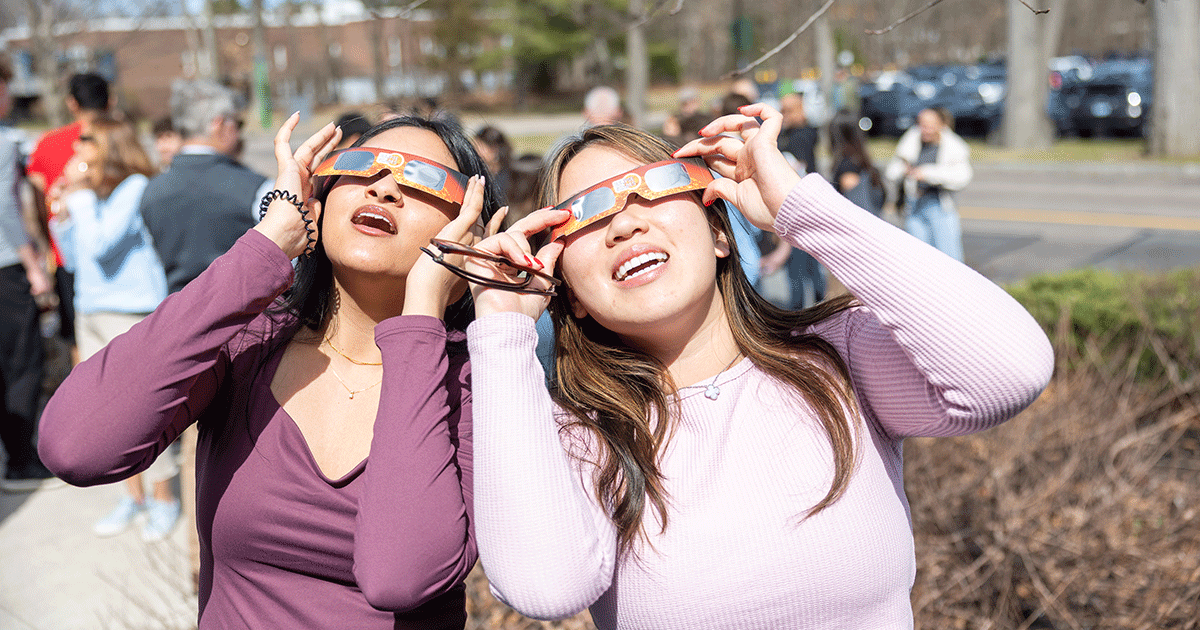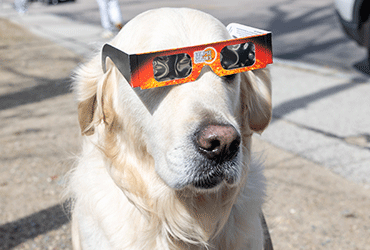A Babson Eclipse Celebration: Moon Pies, Sun Chips, and Roger the Dog

The glasses went fast.
At 2:30 p.m., right as the solar eclipse began on Monday, students outside Babson’s Weissman Foundry began handing out protective eyeglasses. They had 700 pairs. Not even 30 minutes later, they were all gone.
Also going fast were a bunch of eclipse-themed snacks: moon pies, Sun Chips, and SunnyD orange drink. A spirited crowd, made up of dozens upon dozens of students, staff, and faculty, gathered at the Foundry, spilling out onto to the sidewalk. Roger, Babson’s community resource dog, was even there, sporting eclipse glasses.

The crowd took Griffin Zink ’24 by surprise. “We didn’t think it would be this big,” he said. “A lot of people are excited.”
The sky was clear, the weather just about perfect, as Zink manned a makeshift info desk at the Foundry with Evie Barton ’24. Both were part of a class called Eclipses on Earth, which has spent the semester exploring eclipses. The students in the class also taught about the basics of eclipses at local schools.
At the info desk, Zink and Barton had a globe, along with tennis ball serving as the moon and a small volleyball standing in for the sun, on hand to give demonstrations of the cosmic alignment happening in space. Mostly, though, they had to inform a constant parade of people that they had no more glasses. “We are out,” Barton said.
Nearby stood Charles Winrich, the associate teaching professor of physics, who taught the Eclipses on Earth course, which basically has been building toward this moment. “It’s nice the universe cooperated with the academic calendar,” he said.
Winrich had set up a telescope equipped with a filter, so people could take a peek as the moon crept in front of the sun. He remembered the last solar eclipse that Babson experienced in 2017, which didn’t have as large a turnout on campus. The eclipse occurred during the summer and saw the moon covering only about 70 percent of the sun. This time, the sun was 93 percent covered.

“I’m happy so many people came,” Winrich said. “It is one of those times when science is at the top of the news.”
The vibe at the Foundry was celebratory and joyful, a noisy outdoor party with people looking to the sky while wearing weird-looking glasses. “It feels like a community thing,” Matthew Shadid ’27 said. “It felt like something I had to be at.”
As the eclipse reached its peak and the world darkened, Shadid stood among the crowd eating a Mediterranean-style bowl from Mezze. He had hustled over to Reynolds Campus Center, picked it up, and came back. He didn’t want to miss the eclipse, and he didn’t want to miss his Mezze bowl, which he eats every day. “It’s my favorite,” he says. “It’s really good.”
Shadid appreciated how the campus community gathered, all of them so focused on this thing of wonder happening in the heavens. “It’s beautiful watching everyone come together,” he said.
Posted in Community




